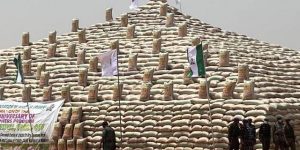Adjudged as the largest rice mill in Sub-Saharan Africa and one of the largest in the world, the Imota rice mill in Lagos, Nigeria launched in January this year by President Muhammadu Buhari brings the number of integrated rice mills in Nigeria to 68, spread all over the country alongside side the other micro, small and medium rice mills in different parts of the country showing an increase in the total number of rice mills in the country in recent times.
While the trend is a good development, one will have to ponder on some questions like what are the propelling factors for the rise in rice mills and what impacts would these have on Nigeria and the continent? Answers to these and many other questions will be provided in this writeup which seeks to explore the rise of rice mills in Nigeria and creation of free trade on the continent using agriculture.
The Nigerian government has a target of improving the agricultural sector to make it a major source of income for the country especially as it pursues its diversification plan, hence, it has come up with various policies and programmes that supports the production of various agricultural produce, and one of such initiative is the rice revolution initiative which has yielded tremendous positive results and brought about over 750 per cent increase in local production of rice as of February 2022 according to data from the central bank of Nigeria.
In Nigeria, like every other nation, rice is a staple food to over 50 per cent of people from across geopolitical zones irrespective of social standing or status, thereby necessitating efforts by the government to ensure the country is self-sufficient in rice production.
The efforts in that regard are actually yielding fruits because through some of these agricultural initiatives, Nigeria can now boost of several small rice mills and about 70 integrated rice mills with a combined production capacity of 3 million metric tons as against less than 350,000 metric tons capacity with 10 integrated millers before the Anchor Borrower Initiative of the present administration.
Before the Anchor Borrower Initiative in 2015, Nigeria had less than 10 integrated rice mills with combined capacity of 350,000 metric tons.
The impact of the anchor borrowers programme alongside efforts by other initiatives such as the Nigeria Incentive-based Risk Sharing System for Agricultural Lending (NIRSAL), which is a $500million non-bank financial institution, wholly-owned by the CBN and the Central Bank of Nigeria (CBN) aggregator scheme helped push the agricultural agenda and had effects on rice cultivation, processing and other value chain activities which in turn led to the increase in rice mills across the country.
For instance, in Kano state, northern Nigeria, the Anchor Borrowers Programme (ABP), through various farmers and agricultural associations encouraged many people to venture into agriculture, especially dry season rice farming which resulted in an increase in the number of rice farmers in the state as demand increased such that between 2015 to 2020, no fewer than 230 micro, small, medium and large rice mills emerged across the state whereby having clusters of small scale rice millers became a norm.
The rise in the rice mills have brought about some meaningful impacts on the economy of states where they are located and the country at large in terms of employment opportunities.
For example, the Imota Rice mill in Lagos state is expected to generate about 250,000 direct and indirect jobs, boost productivity and increase revenue generation for the Lagos state government just as the other mills across the country have opened job opportunities for rural dwellers and created more viable options for rice farmers.
Although, Nigeria’s local production is still below expectation, the potentials are on the high side and there are improvements from what it used to be in the past.
Part of the potentials inherent in Nigeria’s agricultural sector is the impact it is capable of effecting on trade on the continent as it is a known fact that the agricultural sector provides the best possible means through which free trade can be expanded between African nations.
By creating free trade, intra-African trade will be enhanced as expressed in the African Free Trade Area agreement, (AfCFTA).
Quoting the Assistant Director-General and Regional Representative for Africa Food and Agriculture Organization of the United Nations, Mr. Abebe Haile-Gabriel, “it is in agriculture that the AfCFTA’s aspirations can be realized, especially by strengthening regional value streams integrated into priority products, led by a diverse private sector inspired by small business owners, commercial farmers, miners and operators.”
The African Continental Free Trade Area agreement which connects 1.3 billion people across 55 countries with a combined gross domestic product (GDP) valued at US$3.4 trillion will create the largest free trade area in the world measured by the number of countries participating.
Although intra-African agricultural trade remains below 20 percent compared to more than 60 percent for Europe and Asia, trade is projected to grow when the AfCFTA gets the right support and implementation which is dependent on free trade among African nations.
One major thing that is consequential in the achievement of free trade in Africa is the domestication of national legislations of AfCTA trade regimes across African member states for smooth trade transactions as it will help address custom barriers and border closures.
Reducing the infrastructural deficit through building and repairing of good linkage roads, rails, and ports that have over time hindered trade and affected the movement of goods across the continent would also go a long way in enhancing free trade barriers on the continent.
Furthermore, free movement should be encouraged across all African countries to allow Africans travel more freely especially without visa restrictions. Recently, there have been records of improvements on free movements across the continent as noted by the African Development Bank (AfDB) which said travel became more open to African citizens in 2022, with fewer restrictions.
However, the continent still has a long way to go because currently, only a few African countries {Benin, Gambia and Seychelles} allow visa free entry to all Africans.
When barriers of visas are removed, free movement of goods and services would lead to improved trading activities which would grow the economies of all parties involved.
In all, continuous education and sensitization of all African countries on the benefits of free trade to them and their home states are still needed as trade is a continuous process with unending opportunities.
While the discussions on creating free trade in Africa continues to linger despite concerted efforts by governments, regional bodies and the private sector, it is necessary to state that African leaders must not relent, rather they must continue to pursue the goal rigorously more than ever because the market demand will continue to increase bringing about more trade connections that will demand greater and improved trade participation.



